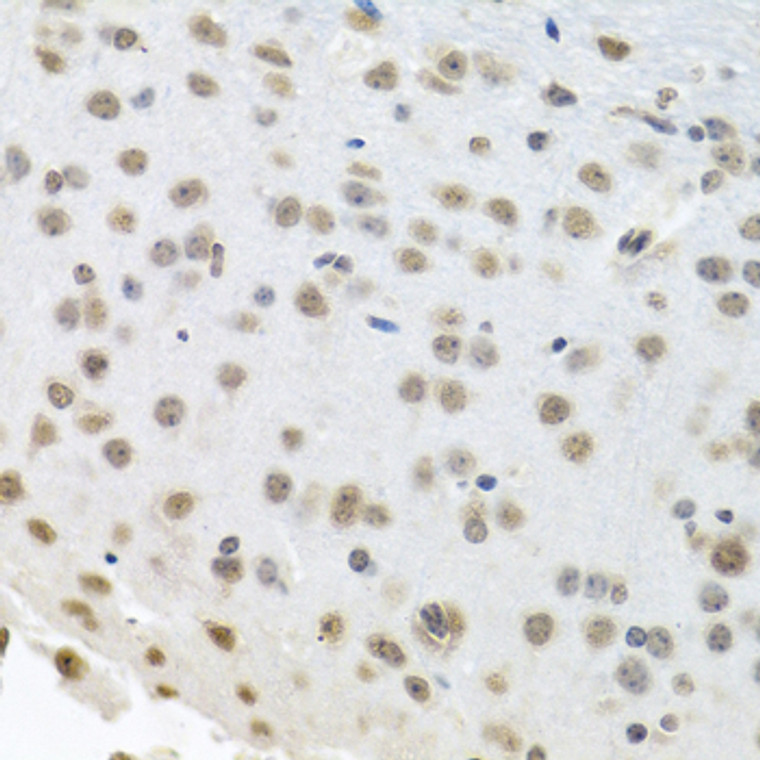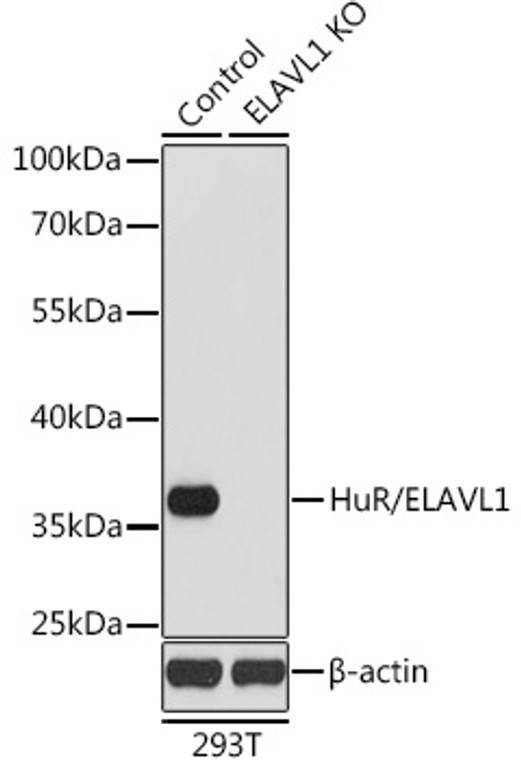| Host: |
Rabbit |
| Applications: |
WB/IHC/IF |
| Reactivity: |
Human/Mouse |
| Note: |
STRICTLY FOR FURTHER SCIENTIFIC RESEARCH USE ONLY (RUO). MUST NOT TO BE USED IN DIAGNOSTIC OR THERAPEUTIC APPLICATIONS. |
| Short Description: |
Rabbit polyclonal antibody anti-HuR/ELAVL1 (1-100) is suitable for use in Western Blot, Immunohistochemistry and Immunofluorescence research applications. |
| Clonality: |
Polyclonal |
| Conjugation: |
Unconjugated |
| Isotype: |
IgG |
| Formulation: |
PBS with 0.02% Sodium Azide, 50% Glycerol, pH7.3. |
| Purification: |
Affinity purification |
| Dilution Range: |
WB 1:500-1:1000IHC-P 1:50-1:200IF/ICC 1:50-1:200 |
| Storage Instruction: |
Store at-20°C for up to 1 year from the date of receipt, and avoid repeat freeze-thaw cycles. |
| Gene Symbol: |
ELAVL1 |
| Gene ID: |
1994 |
| Uniprot ID: |
ELAV1_HUMAN |
| Immunogen Region: |
1-100 |
| Immunogen: |
A synthetic peptide corresponding to a sequence within amino acids 1-100 of human HuR/ELAVL1 (NP_001410.2). |
| Immunogen Sequence: |
MSNGYEDHMAEDCRGDIGRT NLIVNYLPQNMTQDELRSLF SSIGEVESAKLIRDKVAGHS LGYGFVNYVTAKDAERAINT LNGLRLQSKTIKVSYARPSS |
| Tissue Specificity | Ubiquitous. Detected in brain, liver, thymus and muscle. |
| Post Translational Modifications | Phosphorylated by MAPKAPK2. Phosphorylated by PRKCD. Methylated at Arg-217 by CARM1 in macrophages in response to LPS challenge. |
| Function | RNA-binding protein that binds to the 3'-UTR region of mRNAs and increases their stability. Involved in embryonic stem cell (ESC) differentiation: preferentially binds mRNAs that are not methylated by N6-methyladenosine (m6A), stabilizing them, promoting ESC differentiation. Has also been shown to be capable of binding to m6A-containing mRNAs and contributes to MYC stability by binding to m6A-containing MYC mRNAs. Binds to poly-U elements and AU-rich elements (AREs) in the 3'-UTR of target mRNAs. Binds avidly to the AU-rich element in FOS and IL3/interleukin-3 mRNAs. In the case of the FOS AU-rich element, binds to a core element of 27 nucleotides that contain AUUUA, AUUUUA, and AUUUUUA motifs. Binds preferentially to the 5'-UUUUAGUUU-3' motif in vitro. With ZNF385A, binds the 3'-UTR of p53/TP53 mRNA to control their nuclear export induced by CDKN2A. Hence, may regulate p53/TP53 expression and mediate in part the CDKN2A anti-proliferative activity. May also bind with ZNF385A the CCNB1 mRNA. Increases the stability of the leptin mRNA harboring an AU-rich element (ARE) in its 3' UTR. |
| Protein Name | Elav-Like Protein 1Hu-Antigen RHur |
| Database Links | Reactome: R-HSA-450520 |
| Cellular Localisation | CytoplasmNucleusStress GranuleP-BodyTranslocates Into The Cytoplasm Following Phosphorylation By Mapkapk2LikewisePhosphorylation By Prkcd Promotes Translocation From The Nucleus Into The CytoplasmWhere It Is Associated With Free And Cytoskeleton-Bound PolysomesLocalizes To The Stress Granules In The Presence Of Plekhn1 |
| Alternative Antibody Names | Anti-Elav-Like Protein 1 antibodyAnti-Hu-Antigen R antibodyAnti-Hur antibodyAnti-ELAVL1 antibodyAnti-HUR antibody |
Information sourced from Uniprot.org
12 months for antibodies. 6 months for ELISA Kits. Please see website T&Cs for further guidance












